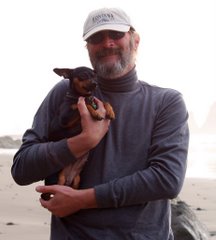As time goes on
I realize
Just what you mean
To me
And now
Now that you're near
Promise your love
That I've waited to share
And dreams
Of our moments together
Color my world with hope of loving you
--from Suite for a Girl from Buchannon by James Pankow

John Wesley
The Man who has had the most influence over me
(other than my father)
Taken 10/8/07 in Buckhannon, West Virginia
This post is a continuation of my post of 10/10/07. Parts of it may not make sense if you have not read the previous post.
Leaving the state hospital, I saw a sign for the public library and headed that way. Faced with a spectacular Victorian building, I read the historic marker sign and learned that the Lewis County Library had been built as a private home. With the loss of father-in-law, husband and son, a fighter pilot in World War I, Mrs. Louis Bennett gave the building to Lewis County to serve as a public library and memorial son. Entering the Louis Bennett Library, I headed for the reference desk. “My great-great-great-etc. grandpappy founded this town according to family history, and I’m just wondering what you might have on Henry Flesher?” The librarian looked me over and said that they really didn’t have much of any local history or family records, but I should try the Central West Virginia Genealogical Library at Horner, a few miles east of town. Directing me past the Rite Aid and CVS pharmacies, past Walmart and McDonald’s, past the I-79 interchange, the librarian told me I couldn’t get lost unless I made a wrong turn. “Terrific,” I thought. Still, it was on the way to Buckhannon, and so I figured I’d check the place out. Since it was open until 8 pm, even on this holiday (Columbus Day), I decided to note its location and continue on to West Virginia Wesleyan College (WVWC).

Pedestrial Bridge
Taken 10/8/07 in Weston, West Virginia
Once I got to Buckhannon, I faced the choice of which exit to take from Corridor H of the Robert C. Byrd Appalachian Highway System. I trust you remember the senior senator from West Virginia, and all the ways he has of promoting his name to a grateful populace. Fortunately there was a sign directing me to take the second exit to reach the college. This I did, and spent the next half hour driving in circles looking for anything that resembled a college—or any other type of institution for that matter. Buckhannon isn’t so large that a college could hide itself easily, or so I thought.
Eventually, I looked down a side street and said “That looks like it could be a college building,” and indeed it was. The next question was where to find the bookstore so I could get some WVWC paraphernalia. Pulling into the Faculty only parking lot in front of the administration building, I asked a woman where I should go. She gave me directions, telling me to park in front of the Wesley Chapel, but warned me that the bookstore was already closed.
Parking where I was directed, I found a student and asked for further directions. He too told me that the bookstore was closed, but that I could look in the windows. Just what I wanted. I did find the store, after a few wrong turns, and it was, as indicated, closed. “You can call in an order, or use the web,” a snack shop worker told me. Looking through the windows, I can’t say that I saw anything that I couldn’t live without, and frankly, orange just isn’t my color.

Wesley Chapel
West Virginia Wesleyan College
Taken 10/8/07 in Buckhannon, West Virginia
The campus looked inviting, but most of the buildings seemed quite new. Founded in 1890 by the West Virginia Conference of the Methodist Episcopal Church, WVWC was the college my parents attended (and Poppa graduated from) in the early 1940s. The more I looked around the campus, the more I became convinced that my parents would not recognize much of anything here today. For this I blame a distant cousin, Jay Rockefeller. (Since this is all about my genealogy, note please that the wife of John D. Rockefeller I was a Spelman from central Ohio. Family legend has it that she was my great-great-grandfather’s cousin.) In the spirit of fairness, I feel obliged to point out that the college’s website gives credit for the current look of the campus to Dr. Stanley H. Martin who served as President from 1957 to 1972. Still all the money had to come from somewhere. In 1884, John D. Rockefeller visited the Atlanta Women’s Seminary, a school for Black women, and liked what he saw. He was generous in his gifts to the school and it was renamed Spelman Seminary, and later Spelman College in honor of his in-laws who had been active in the anti-slavery movement. In 1973, John D. Rockefeller IV, known as Jay, was chosen to be President of WVWC. He served as President until 1976 when he was elected Governor of West Virginia. After two terms in that office, he was elected to the US Senate in 1984 and today he remains the junior Senator from the Mountain State.

Entrance to the Physical Education Center
West Virginia Wesleyan College
Taken 10/8/07 in Buckhannon, West Virginia
I gave up on the idea of finding any roots at WVWC and started the return trip to Parkersburg. It was now past 5 pm and I had an almost empty tank. Still I thought I could at least make a stop at the Genealogical Library to see if it would be worth my while to return when I had more time at my disposal.
The staff was very helpful, and I soon had more citations on the Flesher family than I really cared to go through. Of more interest to me was the family of my great-grandmother whose maiden name was Sarah Rebecca McCalley. I knew, or at least thought I knew, that her father’s name was Solomon P. McCalley and that he came from Lewis County, whose seat, Weston, was just a few miles west of the library. The first book I pulled off the shelves was a McCalley family history that listed both Sarah and Solomon and gave me two generations further back plus a lot of juicy gossip about the family.
Captain James McCalley was a Scottish officer in the Royal Navy at the time of the American Revolution. Instead of fighting against the insurgents, he joined them and stayed in America after the war. The sixth of his seven children was Henry who was born in May, 1790. Henry and his wife Sarah Alkire had eleven children: Solomon P. was the eighth, born in 1828. He married Jane Blackburn and they had three children, of which Sarah Rebecca was the second. I had found more family ties.
Remember where I am. West Virginia is considered a “border state” in American history. The state was created in 1863 when the trans-Allegheny counties of Virginia found a way to free themselves, not from the Confederacy but rather from Richmond, Virginia’s capitol. As folk in outlying areas often do, the mountaineers of the western part of Virginia felt that their needs were not being addressed by the state government. Taking advantage of Virginia’s secession, the people of the west in turn seceded from Virginia, forming the state of West Virginia. Sentiment for the Confederacy was high in the hills and hollers of the new state, but not so high as to keep the people tied to the rest of Virginia.
The McCalleys were Virginians. One of Henry’s nephews, Jonathon McCalley Bennett was state auditor in Virginia and his picture and signature appears on the five dollar Virginia Treasury Note issued during the Civil War. Because of his “act of rebellion,” Bennett was branded a traitor and his lands in Lewis County were forfeited. One of Henry’s brothers, James McCalley, Jr., was the attending physician at the birth of the man who would become known as “Stonewall” Jackson.
Solomon, apparently, did not share his family’s love of the South, or at least of the Confederacy, and his father, Henry, disinherited him. Henry did give a tract of land to Solomon’s brother with the provision that Solomon could live on the land, but that it was to be held in trust for Solomon’s children, including presumably, my great-grandmother.
One of the questions I asked the library staff was just what “Central West Virginia” meant. “Lewis County and those counties surrounding it,” I was told. Most of my family comes from Wood, Jackson and Roane Counties, which do not surround Lewis County. Still, the library had records from those counties as well as from several other states. I made use of what I could find in the limited time I had before the library closed for the day.
One question that had always bothered me concerned my great-grandparents on my mother’s side of the family. Family records said that Great-grandpa Stephens was born in Frederick County, Virginia, in the Shenandoah Valley. The same records said that he married Mary Elizabeth Phelps in Wood County in the Ohio Valley. But I had death records showing that their first two children had been born and had died in Clarke County—back in the Shenandoah. It made no sense to me that Great-grandpa would cross the mountains (and the state) to marry a woman, then take her back across the mountains. At the Central West Virginia Genealogical Library I found the record of the marriage—in Wood County. I guess Grandma had that one right. Still I’d love to know the story behind the peripatetic Henry L. Stephens. This is the same man who took his young family to western Missouri only to return to the Ohio Valley within a few years.
I grew up three thousand miles away from all my blood relatives. What I find amazing today is as I drive around the state, I see family names on all sorts of topographical features. This, of course, is always the case. Bass Creek in Montana is named for the Bass family. Haight Drive in Smith River, California, is named for the Haight family. But the difference here is that when I see McKown Creek, as I did yesterday, or Alkire Hill Road, as I did on Monday, I know that the chances are good that the McKown or Alkire for whom these places are named are probably my ancestors. I’m in a constant state of awe.
Then, of course, there’s my contention that there are only fifteen family names in Jackson County and they’re all in my family tree. For the past two days I stayed at Longfork Campground in rural Roane County. As I started comparing names with the staff there, sure enough, we have lots of common names. West Virginia, it really is all relative.

Chew Mail Pouch
Tobacco Barn in the West Virginia Hills
Taken 10/10/07 in Wirt County, West Virginia
And as for that. Back in the early years of this decade, the clothing chain Abercrombie and Fitch came up with the clever idea of putting out a line of t-shirts with new state mottos. I don’t know what happened with their other mottos, but the one they used for West Virginia was “It’s All Relative.” This created quite a stir. The Governor tried to get a boycott of A&F. Nasty letters were posted on bulletin boards and in chat rooms. The t-shirts disappeared from the stores. Everyone I’ve talked to tried to get one of the shirts before A&F pulled them. Some people just don’t have any sense of humor, I guess. Deliver me from Political Correctness.









No comments:
Post a Comment